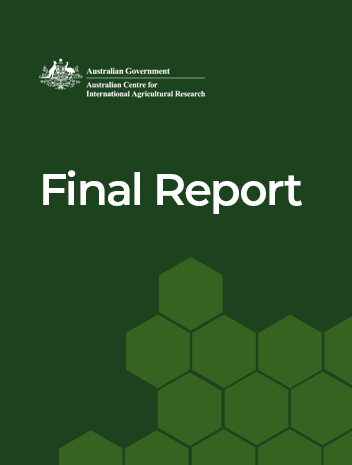- HomeHome
-
About ACIAR
- Our work
- Our people
-
Corporate information
- ACIAR Audit Committee
- Commission for International Agricultural Research
- Policy Advisory Council
- Agency reviews
- Executive remuneration disclosure
- Freedom of information (FOI)
- Gifts and benefits register
- Information publication scheme
- List of new agency files
- Contracts
- Legal services expenditure
- Privacy impact assessment register
- Commonwealth Child Safe Framework
- Benefits to Australia
- Careers
- 40 years of ACIAR
-
What we do
- Programs
- Cross-cutting areas
- Resources
- Where we work
-
Funding
- Research projects
- Fellowships
-
Scholarships
- John Allwright FellowshipScholarships to study in Australia for ACIAR partner country scientists to have Australian postgraduate qualifications
- ACIAR Pacific Agriculture Scholarships and Support and Climate Resilience Program
- Alumni Research Support Facility
- Publications
- News and Outreach
Project final report
Integrating protected cropping systems into high value vegetable value chains in the Pacific and Australia - Final Report
Date released
19 June 2023
ISBN
978-1-922-983-18-3
Publication Code
FR2023-022
Overview
This project aimed to promote the adoption of protected cropping systems appropriate for use in Pacific Island Countries and to support growers producing vegetable crops using protected cropping systems in Fiji, Samoa, and Tonga to access high-value markets for their produce.
Vegetable production does not match local demand and the shortfall is supplied by imports. Horticultural crop production in Fiji, Samoa, and Tonga is largely conducted by smallholders who are in general unable to supply the large tourist industry market as field production of crops is constrained by high precipitation damage in the wet season and lack of water in the dry season.
If the demand for vegetables was met by local producers, income from high-value vegetable production would improve the livelihoods of producers and their communities. In the Pacific Island Countries, protected cropping for small- and medium-scale farmers is new, and a potentially transformational and enabling technology for vegetable production systems. Although there has been limited use of protective cropping in Fiji and Samoa, increasing recognition by the governments in both countries of the potential impact of protected cropping for domestic food security and for economic development in rural communities has seen the production system emerge as a priority for domestic agriculture and donor aid development programs.
This project assessed a range of protected cropping technologies suitable for smallholders in farmers using a variety of market access strategies. This work will ensure agricultural interventions supporting the development of protected cropping systems can include awareness of potential health and nutrition impacts and is intended to reduce the risk of unintended negative health consequences emerging from the development of protected cropping systems in the Pacific Island Countries.
- Protected cropping production systems were demonstrated to have the potential to allow farmers in Pacific Island Countries to access high-value markets for vegetable products that are otherwise very difficult to access with conventional production systems.
- High marketable yields and gross margins for tomato, capsicum, and cucumber crops grown in high, passively-vented structures were demonstrated. However, the skills and knowledge required to manage the structures and the production systems differ from field production, and farmers investing in these systems must acquire the skills and knowledge to balance the investment risks in establishing the systems.
- There is a range of potential protective structures for warm and tropical climates, and the level of risk varies between the structures and production systems. Which structure design is best suited for a grower will depend on several factors, most notably crop species to be grown, plant growing system, specific environmental and biological constraints of the location, desired level of environmental control, expected strength and durability of the structure, investment budget available and access to appropriate markets for produce.
- Protected cropping resulted in higher yields of vegetables in both wet and dry seasons. Adoption of this technology across the Pacific Island Countries would contribute to improved food security at national levels, as well as being a source of income for smallholder farmers and having the potential to contribute to improved human nutrition and health through greater availability of affordable vegetables.
- Investment in protected cropping structures for vegetables is economically feasible in Pacific Island Countries, especially for skilled growers who apply appropriate inputs.
- For imported steel structures, a return on investment in 2 to 4 years is achievable while basic structures using locally available materials and cheap plastic covers may be profitable for farmers in less than 2 years. Non-steel structures do however degrade rapidly under tropical environmental conditions so farmers engaging with protected cropping for the first time with such structures need to plan for future investments to replace or upgrade the structure if they are to continue using protected cropping.
- The concept of a stepped progression with increasing levels of sophistication in protected cropping systems is valuable in promoting protected cropping as it helps farmers see the need to upgrade both structures and technical skills if they are to progress to more advanced systems.



